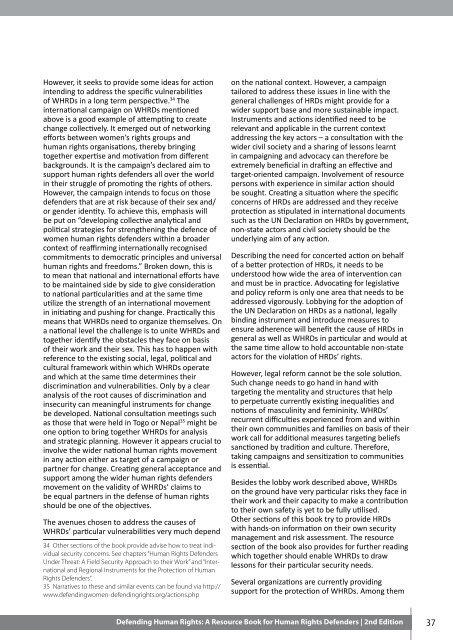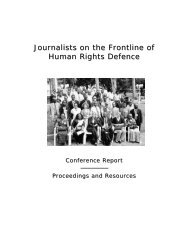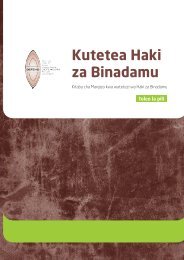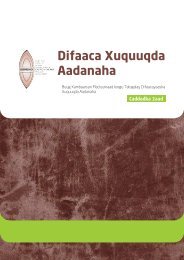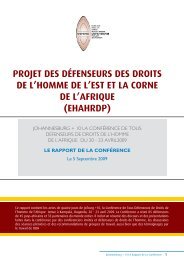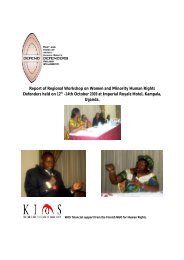Defending Human Rights: A Resource Book for Human
Defending Human Rights: A Resource Book for Human
Defending Human Rights: A Resource Book for Human
You also want an ePaper? Increase the reach of your titles
YUMPU automatically turns print PDFs into web optimized ePapers that Google loves.
However, it seeks to provide some ideas <strong>for</strong> action<br />
intending to address the specific vulnerabilities<br />
of WHRDs in a long term perspective. 34 The<br />
international campaign on WHRDs mentioned<br />
above is a good example of attempting to create<br />
change collectively. It emerged out of networking<br />
ef<strong>for</strong>ts between women’s rights groups and<br />
human rights organisations, thereby bringing<br />
together expertise and motivation from different<br />
backgrounds. It is the campaign’s declared aim to<br />
support human rights defenders all over the world<br />
in their struggle of promoting the rights of others.<br />
However, the campaign intends to focus on those<br />
defenders that are at risk because of their sex and/<br />
or gender identity. To achieve this, emphasis will<br />
be put on “developing collective analytical and<br />
political strategies <strong>for</strong> strengthening the defence of<br />
women human rights defenders within a broader<br />
context of reaffirming internationally recognised<br />
commitments to democratic principles and universal<br />
human rights and freedoms.” Broken down, this is<br />
to mean that national and international ef<strong>for</strong>ts have<br />
to be maintained side by side to give consideration<br />
to national particularities and at the same time<br />
utilize the strength of an international movement<br />
in initiating and pushing <strong>for</strong> change. Practically this<br />
means that WHRDs need to organize themselves. On<br />
a national level the challenge is to unite WHRDs and<br />
together identify the obstacles they face on basis<br />
of their work and their sex. This has to happen with<br />
reference to the existing social, legal, political and<br />
cultural framework within which WHRDs operate<br />
and which at the same time determines their<br />
discrimination and vulnerabilities. Only by a clear<br />
analysis of the root causes of discrimination and<br />
insecurity can meaningful instruments <strong>for</strong> change<br />
be developed. National consultation meetings such<br />
as those that were held in Togo or Nepal 35 might be<br />
one option to bring together WHRDs <strong>for</strong> analysis<br />
and strategic planning. However it appears crucial to<br />
involve the wider national human rights movement<br />
in any action either as target of a campaign or<br />
partner <strong>for</strong> change. Creating general acceptance and<br />
support among the wider human rights defenders<br />
movement on the validity of WHRDs’ claims to<br />
be equal partners in the defense of human rights<br />
should be one of the objectives.<br />
The avenues chosen to address the causes of<br />
WHRDs’ particular vulnerabilities very much depend<br />
34 Other sections of the book provide advise how to treat individual<br />
security concerns. See chapters “<strong>Human</strong> <strong>Rights</strong> Defenders<br />
Under Threat: A Field Security Approach to their Work” and “International<br />
and Regional Instruments <strong>for</strong> the Protection of <strong>Human</strong><br />
<strong>Rights</strong> Defenders”.<br />
35 Narratives to these and similar events can be found via http://<br />
www.defendingwomen-defendingrights.org/actions.php<br />
on the national context. However, a campaign<br />
tailored to address these issues in line with the<br />
general challenges of HRDs might provide <strong>for</strong> a<br />
wider support base and more sustainable impact.<br />
Instruments and actions identified need to be<br />
relevant and applicable in the current context<br />
addressing the key actors – a consultation with the<br />
wider civil society and a sharing of lessons learnt<br />
in campaigning and advocacy can there<strong>for</strong>e be<br />
extremely beneficial in drafting an effective and<br />
target-oriented campaign. Involvement of resource<br />
persons with experience in similar action should<br />
be sought. Creating a situation where the specific<br />
concerns of HRDs are addressed and they receive<br />
protection as stipulated in international documents<br />
such as the UN Declaration on HRDs by government,<br />
non-state actors and civil society should be the<br />
underlying aim of any action.<br />
Describing the need <strong>for</strong> concerted action on behalf<br />
of a better protection of HRDs, it needs to be<br />
understood how wide the area of intervention can<br />
and must be in practice. Advocating <strong>for</strong> legislative<br />
and policy re<strong>for</strong>m is only one area that needs to be<br />
addressed vigorously. Lobbying <strong>for</strong> the adoption of<br />
the UN Declaration on HRDs as a national, legally<br />
binding instrument and introduce measures to<br />
ensure adherence will benefit the cause of HRDs in<br />
general as well as WHRDs in particular and would at<br />
the same time allow to hold accountable non-state<br />
actors <strong>for</strong> the violation of HRDs’ rights.<br />
However, legal re<strong>for</strong>m cannot be the sole solution.<br />
Such change needs to go hand in hand with<br />
targeting the mentality and structures that help<br />
to perpetuate currently existing inequalities and<br />
notions of masculinity and femininity. WHRDs’<br />
recurrent difficulties experienced from and within<br />
their own communities and families on basis of their<br />
work call <strong>for</strong> additional measures targeting beliefs<br />
sanctioned by tradition and culture. There<strong>for</strong>e,<br />
taking campaigns and sensitization to communities<br />
is essential.<br />
Besides the lobby work described above, WHRDs<br />
on the ground have very particular risks they face in<br />
their work and their capacity to make a contribution<br />
to their own safety is yet to be fully utilised.<br />
Other sections of this book try to provide HRDs<br />
with hands-on in<strong>for</strong>mation on their own security<br />
management and risk assessment. The resource<br />
section of the book also provides <strong>for</strong> further reading<br />
which together should enable WHRDs to draw<br />
lessons <strong>for</strong> their particular security needs.<br />
Several organizations are currently providing<br />
support <strong>for</strong> the protection of WHRDs. Among them<br />
<strong>Defending</strong> <strong>Human</strong> <strong>Rights</strong>: A <strong>Resource</strong> <strong>Book</strong> <strong>for</strong> <strong>Human</strong> <strong>Rights</strong> Defenders | 2nd Edition 37


